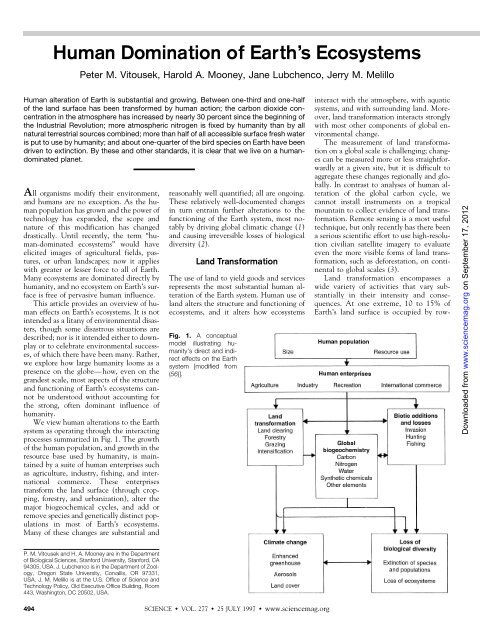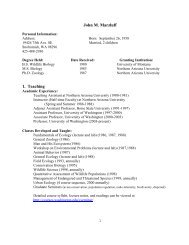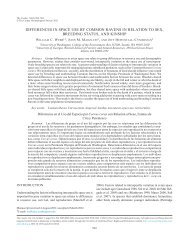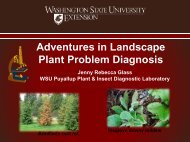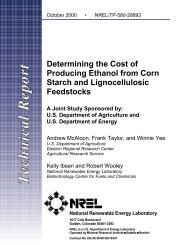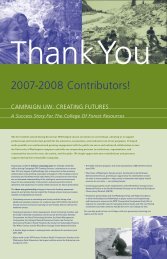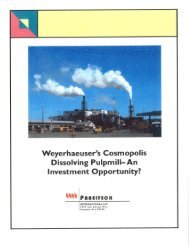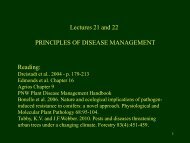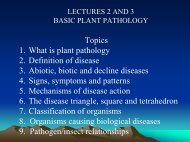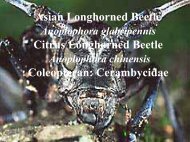Human Domination of Earth's Ecosystems - School of Environmental ...
Human Domination of Earth's Ecosystems - School of Environmental ...
Human Domination of Earth's Ecosystems - School of Environmental ...
You also want an ePaper? Increase the reach of your titles
YUMPU automatically turns print PDFs into web optimized ePapers that Google loves.
Alterations <strong>of</strong> theBiogeochemical CyclesCarbon. Life on Earth is based on carbon,and the CO 2in the atmosphere is the primaryresource for photosynthesis. <strong>Human</strong>ityadds CO 2to the atmosphere by mining andburning fossil fuels, the residue <strong>of</strong> life fromthe distant past, and by converting forestsand grasslands to agricultural and otherlow-biomass ecosystems. The net result <strong>of</strong>both activities is that organic carbon fromrocks, organisms, and soils is released intothe atmosphere as CO 2.The modern increase in CO 2representsthe clearest and best documented signal <strong>of</strong>human alteration <strong>of</strong> the Earth system.Thanks to the foresight <strong>of</strong> Roger Revelle,Charles Keeling, and others who initiatedcareful and systematic measurements <strong>of</strong> atmosphericCO 2in 1957 and sustained themthrough budget crises and changes in scientificfashions, we have observed the concentration<strong>of</strong> CO 2as it has increased steadilyfrom 315 ppm to 362 ppm. Analysis <strong>of</strong> airbubbles extracted from the Antarctic andGreenland ice caps extends the record backmuch further; the CO 2concentration wasmore or less stable near 280 ppm for thousands<strong>of</strong> years until about 1800, and hasincreased exponentially since then (17).NP60°30°EQThere is no doubt that this increase hasbeen driven by human activity, today primarilyby fossil fuel combustion. The sources<strong>of</strong> CO 2can be traced isotopically; beforethe period <strong>of</strong> extensive nuclear testing inthe atmosphere, carbon depleted in 14 C wasa specific tracer <strong>of</strong> CO 2derived from fossilfuel combustion, whereas carbon depletedin 13 C characterized CO 2from both fossilfuels and land transformation. Direct measurementsin the atmosphere, and analyses<strong>of</strong> carbon isotopes in tree rings, show thatboth 13 C and 14 CinCO 2were diluted inthe atmosphere relative to 12 C as the CO 2concentration in the atmosphere increased.Fossil fuel combustion now adds 5.5 0.5 billion metric tons <strong>of</strong> CO 2-Ctotheatmosphere annually, mostly in economicallydeveloped regions <strong>of</strong> the temperatezone (18) (Fig. 4). The annual accumulation<strong>of</strong> CO 2-C has averaged 3.2 0.2billion metric tons recently (17). The othermajor terms in the atmospheric carbonbalance are net ocean-atmosphere flux,net release <strong>of</strong> carbon during land transformation,and net storage in terrestrial biomassand soil organic matter. All <strong>of</strong> theseterms are smaller and less certain thanfossil fuel combustion or annual atmosphericaccumulation; they represent richareas <strong>of</strong> current research, analysis, andsometimes contention.The human-caused increase in atmosphericCO 2already represents nearly a30% change relative to the pre-industrialera (Fig. 2), and CO 2will continue to increasefor the foreseeable future. IncreasedCO 2represents the most important humanenhancement to the greenhouse effect; theconsensus <strong>of</strong> the climate research communityis that it probably already affects climatedetectably and will drive substantialclimate change in the next century (1). Thedirect effects <strong>of</strong> increased CO 2on plantsand ecosystems may be even more important.The growth <strong>of</strong> most plants is enhancedby elevated CO 2, but to very different extents;the tissue chemistry <strong>of</strong> plants thatrespond to CO 2is altered in ways thatdecrease food quality for animals and microbes;and the water use efficiency <strong>of</strong>plants and ecosystems generally is increased.The fact that increased CO 2affectsspecies differentially means that it is likelyto drive substantial changes in the speciescomposition and dynamics <strong>of</strong> all terrestrialecosystems (19).Water. Water is essential to all life. Itsmovement by gravity, and through evaporationand condensation, contributes to drivingEarth’s biogeochemical cycles and tocontrolling its climate. Very little <strong>of</strong> theDownloaded from www.sciencemag.org on September 17, 201230°60°SP180° 120°W 60°W 0°60°E120°E180°50 100 150 200 250 300 350 400 450Emissions (g m -2 year -1 )Fig. 4. Geographical distribution <strong>of</strong> fossil fuel sources <strong>of</strong> CO 2 as <strong>of</strong> 1990. The global mean is 12.2 g m 2 year 1 ; most emissions occur in economicallydeveloped regions <strong>of</strong> the north temperate zone. EQ, equator; NP, North Pole; SP, South Pole. [Prepared by A. S. Denning, from information in (18)]496SCIENCE VOL. 277 25 JULY 1997 www.sciencemag.org
HUMAN-DOMINATED ECOSYSTEMS: ARTICLESwater on Earth is directly usable by humans;most is either saline or frozen. Globally, humanitynow uses more than half <strong>of</strong> the run<strong>of</strong>fwater that is fresh and reasonably accessible,with about 70% <strong>of</strong> this use in agriculture(20) (Fig. 2). To meet increasing demandsfor the limited supply <strong>of</strong> fresh water, humanityhas extensively altered river systemsthrough diversions and impoundments. Inthe United States only 2% <strong>of</strong> the rivers rununimpeded, and by the end <strong>of</strong> this centurythe flow <strong>of</strong> about two-thirds <strong>of</strong> all <strong>of</strong> Earth’srivers will be regulated (21). At present, asmuch as 6% <strong>of</strong> Earth’s river run<strong>of</strong>f is evaporatedas a consequence <strong>of</strong> human manipulations(22). Major rivers, including the Colorado,the Nile, and the Ganges, are used soextensively that little water reaches the sea.Massive inland water bodies, including theAral Sea and Lake Chad, have been greatlyreduced in extent by water diversions foragriculture. Reduction in the volume <strong>of</strong> theAral Sea resulted in the demise <strong>of</strong> nativefishes and the loss <strong>of</strong> other biota; the loss <strong>of</strong>a major fishery; exposure <strong>of</strong> the salt-laden seabottom, thereby providing a major source <strong>of</strong>windblown dust; the production <strong>of</strong> a drierand more continental local climate and adecrease in water quality in the general region;and an increase in human diseases(23).Impounding and impeding the flow <strong>of</strong>rivers provides reservoirs <strong>of</strong> water that can beused for energy generation as well as foragriculture. Waterways also are managed fortransport, for flood control, and for the dilution<strong>of</strong> chemical wastes. Together, these activitieshave altered Earth’s freshwater ecosystemspr<strong>of</strong>oundly, to a greater extent thanterrestrial ecosystems have been altered. Theconstruction <strong>of</strong> dams affects biotic habitatsindirectly as well; the damming <strong>of</strong> the DanubeRiver, for example, has altered the silicachemistry <strong>of</strong> the entire Black Sea. The largenumber <strong>of</strong> operational dams (36,000) in theworld, in conjunction with the many thatare planned, ensure that humanity’s effectson aquatic biological systems will continue(24). Where surface water is sparse or overexploited,humans use groundwater—and inmany areas the groundwater that is drawnupon is nonrenewable, or fossil, water (25).For example, three-quarters <strong>of</strong> the water supply<strong>of</strong> Saudi Arabia currently comes fromfossil water (26).Alterations to the hydrological cycle canaffect regional climate. Irrigation increasesatmospheric humidity in semiarid areas, <strong>of</strong>tenincreasing precipitation and thunderstormfrequency (27). In contrast, landtransformation from forest to agriculture orpasture increases albedo and decreases surfaceroughness; simulations suggest that thenet effect <strong>of</strong> this transformation is to increasetemperature and decrease precipitationregionally (7, 26).Conflicts arising from the global use <strong>of</strong>water will be exacerbated in the yearsahead, with a growing human populationand with the stresses that global changeswill impose on water quality and availability.Of all <strong>of</strong> the environmental securityissues facing nations, an adequate supply <strong>of</strong>clean water will be the most important.Nitrogen. Nitrogen (N) is unique amongthe major elements required for life, in thatits cycle includes a vast atmospheric reservoir(N 2) that must be fixed (combinedwith carbon, hydrogen, or oxygen) before itcan be used by most organisms. The supply<strong>of</strong> this fixed N controls (at least in part) theproductivity, carbon storage, and speciescomposition <strong>of</strong> many ecosystems. Before theextensive human alteration <strong>of</strong> the N cycle,90 to 130 million metric tons <strong>of</strong> N (Tg N)were fixed biologically on land each year;rates <strong>of</strong> biological fixation in marine systemsare less certain, but perhaps as muchwas fixed there (28).<strong>Human</strong> activity has altered the globalcycle <strong>of</strong> N substantially by fixing N 2—deliberatelyfor fertilizer and inadvertentlyduring fossil fuel combustion. Industrial fixation<strong>of</strong> N fertilizer increased from 10Tg/year in 1950 to 80 Tg/year in 1990; aftera brief dip caused by economic dislocationsin the former Soviet Union, it is expectedto increase to 135 Tg/year by 2030 (29).Cultivation <strong>of</strong> soybeans, alfalfa, and otherlegume crops that fix N symbiotically enhancesfixation by another 40 Tg/year,and fossil fuel combustion puts 20 Tg/year<strong>of</strong> reactive N into the atmosphere globally—someby fixing N 2, more from the mobilization<strong>of</strong> N in the fuel. Overall, humanactivity adds at least as much fixed N toterrestrial ecosystems as do all naturalsources combined (Fig. 2), and it mobilizes50 Tg/year more during land transformation(28, 30).Alteration <strong>of</strong> the N cycle has multipleconsequences. In the atmosphere, these include(i) an increasing concentration <strong>of</strong> thegreenhouse gas nitrous oxide globally; (ii)substantial increases in fluxes <strong>of</strong> reactive Ngases (two-thirds or more <strong>of</strong> both nitric oxideand ammonia emissions globally are humancaused);and (iii) a substantial contributionto acid rain and to the photochemical smogthat afflicts urban and agricultural areasthroughout the world (31). Reactive N thatis emitted to the atmosphere is depositeddownwind, where it can influence the dynamics<strong>of</strong> recipient ecosystems. In regionswhere fixed N was in short supply, added Ngenerally increases productivity and C storagewithin ecosystems, and ultimately increaseslosses <strong>of</strong> N and cations from soils, ina set <strong>of</strong> processes termed “N saturation” (32).Where added N increases the productivity <strong>of</strong>ecosystems, usually it also decreases theirbiological diversity (33).<strong>Human</strong>-fixed N also can move from agriculture,from sewage systems, and fromN-saturated terrestrial systems to streams,rivers, groundwater, and ultimately theoceans. Fluxes <strong>of</strong> N through streams andrivers have increased markedly as humanalteration <strong>of</strong> the N cycle has accelerated;river nitrate is highly correlated with thehuman population <strong>of</strong> river basins and withthe sum <strong>of</strong> human-caused N inputs to thosebasins (8). Increases in river N drive theeutrophication <strong>of</strong> most estuaries, causingblooms <strong>of</strong> nuisance and even toxic algae,and threatening the sustainability <strong>of</strong> marinefisheries (16, 34).Other cycles. The cycles <strong>of</strong> carbon, water,and nitrogen are not alone in being alteredby human activity. <strong>Human</strong>ity is also thelargest source <strong>of</strong> oxidized sulfur gases in theatmosphere; these affect regional air quality,biogeochemistry, and climate. Moreover,mining and mobilization <strong>of</strong> phosphorusand <strong>of</strong> many metals exceed their naturalfluxes; some <strong>of</strong> the metals that are concentratedand mobilized are highly toxic (includinglead, cadmium, and mercury) (35).Beyond any doubt, humanity is a majorbiogeochemical force on Earth.Synthetic organic chemicals. Synthetic organicchemicals have brought humanitymany beneficial services. However, manyare toxic to humans and other species, andsome are hazardous in concentrations as lowas 1 part per billion. Many chemicals persistin the environment for decades; some areboth toxic and persistent. Long-lived organochlorinecompounds provide the clearestexamples <strong>of</strong> environmental consequences<strong>of</strong> persistent compounds. Insecticidessuch as DDT and its relatives, and industrialcompounds like polychlorinated biphenyls(PCBs), were used widely in North Americain the 1950s and 1960s. They were transportedglobally, accumulated in organisms,and magnified in concentration throughfood chains; they devastated populations <strong>of</strong>some predators (notably falcons and eagles)and entered parts <strong>of</strong> the human food supplyin concentrations higher than was prudent.Domestic use <strong>of</strong> these compounds wasphased out in the 1970s in the UnitedStates and Canada, and their concentrationsdeclined thereafter. However, PCBsin particular remain readily detectable inmany organisms, sometimes approachingthresholds <strong>of</strong> public health concern (36).They will continue to circulate throughorganisms for many decades.Synthetic chemicals need not be toxicto cause environmental problems. The factthat the persistent and volatile chlor<strong>of</strong>luorocarbons(CFCs) are wholly nontoxic contributedto their widespread use as refriger-Downloaded from www.sciencemag.org on September 17, 2012www.sciencemag.org SCIENCE VOL. 277 25 JULY 1997 497
ants and even aerosol propellants. The subsequentdiscovery that CFCs drive thebreakdown <strong>of</strong> stratospheric ozone, and especiallythe later discovery <strong>of</strong> the Antarcticozone hole and their role in it, representgreat surprises in global environmental science(37). Moreover, the response <strong>of</strong> theinternational political system to those discoveriesis the best extant illustration thatglobal environmental change can be dealtwith effectively (38).Particular compounds that pose serioushealth and environmental threats can beand <strong>of</strong>ten have been phased out (althoughPCB production is growing in Asia). Nonetheless,each year the chemical industryproduces more than 100 million tons <strong>of</strong>organic chemicals representing some 70,000different compounds, with about 1000 newones being added annually (39). Only asmall fraction <strong>of</strong> the many chemicals producedand released into the environmentare tested adequately for health hazards orenvironmental impact (40).Biotic Changes<strong>Human</strong> modification <strong>of</strong> Earth’s biologicalresources—its species and genetically distinctpopulations—is substantial and growing.Extinction is a natural process, but thecurrent rate <strong>of</strong> loss <strong>of</strong> genetic variability, <strong>of</strong>populations, and <strong>of</strong> species is far abovebackground rates; it is ongoing; and it representsa wholly irreversible global change.At the same time, human transport <strong>of</strong> speciesaround Earth is homogenizing Earth’sbiota, introducing many species into newareas where they can disrupt both naturaland human systems.Losses. Rates <strong>of</strong> extinction are difficultto determine globally, in part because themajority <strong>of</strong> species on Earth have not yetbeen identified. Nevertheless, recent calculationssuggest that rates <strong>of</strong> species extinctionare now on the order <strong>of</strong> 100 to 1000times those before humanity’s dominance <strong>of</strong>Earth (41). For particular well-knowngroups, rates <strong>of</strong> loss are even greater; asmany as one-quarter <strong>of</strong> Earth’s bird specieshave been driven to extinction by humanactivities over the past two millennia,particularly on oceanic islands (42) (Fig. 2).At present, 11% <strong>of</strong> the remaining birds,18% <strong>of</strong> the mammals, 5% <strong>of</strong> fish, and 8% <strong>of</strong>plant species on Earth are threatened withextinction (43). There has been a disproportionateloss <strong>of</strong> large mammal speciesbecause <strong>of</strong> hunting; these species played adominant role in many ecosystems, andtheir loss has resulted in a fundamentalchange in the dynamics <strong>of</strong> those systems(44), one that could lead to further extinctions.The largest organisms in marinesystems have been affected similarly, byfishing and whaling. Land transformation isthe single most important cause <strong>of</strong> extinction,and current rates <strong>of</strong> land transformationeventually will drive manymore species to extinction, although witha time lag that masks the true dimensions<strong>of</strong> the crisis (45). Moreover, the effects <strong>of</strong>other components <strong>of</strong> global environmentalchange—<strong>of</strong> altered carbon and nitrogencycles, and <strong>of</strong> anthropogenic climatechange—are just beginning.As high as they are, these losses <strong>of</strong> speciesunderstate the magnitude <strong>of</strong> loss <strong>of</strong>genetic variation. The loss to land transformation<strong>of</strong> locally adapted populations withinspecies, and <strong>of</strong> genetic material withinpopulations, is a human-caused change thatreduces the resilience <strong>of</strong> species and ecosystemswhile precluding human use <strong>of</strong> thelibrary <strong>of</strong> natural products and genetic materialthat they represent (46).Although conservation efforts focusedon individual endangered species haveyielded some successes, they are expensive—andthe protection or restoration <strong>of</strong>whole ecosystems <strong>of</strong>ten represents the mosteffective way to sustain genetic, population,and species diversity. Moreover, ecosystemsthemselves may play important roles inboth natural and human-dominated landscapes.For example, mangrove ecosystemsprotect coastal areas from erosion and providenurseries for <strong>of</strong>fshore fisheries, but theyare threatened by land transformation inmany areas.Invasions. In addition to extinction, humanityhas caused a rearrangement <strong>of</strong>Earth’s biotic systems, through the mixing<strong>of</strong> floras and faunas that had long beenisolated geographically. The magnitude <strong>of</strong>transport <strong>of</strong> species, termed “biological invasion,”is enormous (47); invading speciesare present almost everywhere. On manyislands, more than half <strong>of</strong> the plant speciesare nonindigenous, and in many continentalareas the figure is 20% or more (48) (Fig.2).As with extinction, biological invasionoccurs naturally—and as with extinction,human activity has accelerated its rate byorders <strong>of</strong> magnitude. Land transformationinteracts strongly with biological invasion,in that human-altered ecosystems generallyprovide the primary foci for invasions, whilein some cases land transformation itself isdriven by biological invasions (49). Internationalcommerce is also a primary cause<strong>of</strong> the breakdown <strong>of</strong> biogeographic barriers;trade in live organisms is massive and global,and many other organisms are inadvertentlytaken along for the ride. In freshwatersystems, the combination <strong>of</strong> upstreamland transformation, altered hydrology, andnumerous deliberate and accidental speciesintroductions has led to particularly widespreadinvasion, in continental as well asisland ecosystems (50).In some regions, invasions are becomingmore frequent. For example, in the SanFrancisco Bay <strong>of</strong> California, an average <strong>of</strong>one new species has been established every36 weeks since 1850, every 24 weeks since1970, and every 12 weeks for the last decade(51). Some introduced species quickly becomeinvasive over large areas (for example,the Asian clam in the San Francisco Bay),whereas others become widespread only aftera lag <strong>of</strong> decades, or even over a century(52).Many biological invasions are effectivelyirreversible; once replicating biological materialis released into the environment andbecomes successful there, calling it back isdifficult and expensive at best. Moreover,some species introductions have consequences.Some degrade human health andthat <strong>of</strong> other species; after all, most infectiousdiseases are invaders over most <strong>of</strong> theirrange. Others have caused economic lossesamounting to billions <strong>of</strong> dollars; the recentinvasion <strong>of</strong> North America by the zebramussel is a well-publicized example. Somedisrupt ecosystem processes, altering thestructure and functioning <strong>of</strong> whole ecosystems.Finally, some invasions drive losses inthe biological diversity <strong>of</strong> native species andpopulations; after land transformation, theyare the next most important cause <strong>of</strong> extinction(53).ConclusionsThe global consequences <strong>of</strong> human activityare not something to face in the future—asFig. 2 illustrates, they are with us now. All<strong>of</strong> these changes are ongoing, and in manycases accelerating; many <strong>of</strong> them were entrainedlong before their importance wasrecognized. Moreover, all <strong>of</strong> these seeminglydisparate phenomena trace to a singlecause—the growing scale <strong>of</strong> the human enterprise.The rates, scales, kinds, and combinations<strong>of</strong> changes occurring now are fundamentallydifferent from those at any othertime in history; we are changing Earthmore rapidly than we are understanding it.We live on a human-dominated planet—and the momentum <strong>of</strong> human populationgrowth, together with the imperative forfurther economic development in most <strong>of</strong>the world, ensures that our dominance willincrease.The papers in this special section summarizeour knowledge <strong>of</strong> and provide specificpolicy recommendations concerningmajor human-dominated ecosystems. In addition,we suggest that the rate and extent<strong>of</strong> human alteration <strong>of</strong> Earth should affecthow we think about Earth. It is clear thatwe control much <strong>of</strong> Earth, and that ourDownloaded from www.sciencemag.org on September 17, 2012498SCIENCE VOL. 277 25 JULY 1997 www.sciencemag.org
HUMAN-DOMINATED ECOSYSTEMS: ARTICLESactivities affect the rest. In a very real sense,the world is in our hands—and how wehandle it will determine its compositionand dynamics, and our fate.Recognition <strong>of</strong> the global consequences<strong>of</strong> the human enterprise suggests three complementarydirections. First, we can work toreduce the rate at which we alter the Earthsystem. <strong>Human</strong>s and human-dominated systemsmay be able to adapt to slower change,and ecosystems and the species they supportmay cope more effectively with the changeswe impose, if those changes are slow. Ourfootprint on the planet (54) might then bestabilized at a point where enough spaceand resources remain to sustain most <strong>of</strong> theother species on Earth, for their sake andour own. Reducing the rate <strong>of</strong> growth inhuman effects on Earth involves slowinghuman population growth and using resourcesas efficiently as is practical. Often itis the waste products and by-products <strong>of</strong>human activity that drive global environmentalchange.Second, we can accelerate our efforts tounderstand Earth’s ecosystems and howthey interact with the numerous components<strong>of</strong> human-caused global change. Ecologicalresearch is inherently complex anddemanding: It requires measurement andmonitoring <strong>of</strong> populations and ecosystems;experimental studies to elucidate the regulation<strong>of</strong> ecological processes; the development,testing, and validation <strong>of</strong> regionaland global models; and integration with abroad range <strong>of</strong> biological, earth, atmospheric,and marine sciences. The challenge <strong>of</strong>understanding a human-dominated planetfurther requires that the human dimensions<strong>of</strong> global change—the social, economic,cultural, and other drivers <strong>of</strong> human actions—beincluded within our analyses.Finally, humanity’s dominance <strong>of</strong> Earthmeans that we cannot escape responsibilityfor managing the planet. Our activitiesare causing rapid, novel, and substantialchanges to Earth’s ecosystems.Maintaining populations, species, andecosystems in the face <strong>of</strong> those changes,and maintaining the flow <strong>of</strong> goods andservices they provide humanity (55), willrequire active management for the foreseeablefuture. There is no clearer illustration<strong>of</strong> the extent <strong>of</strong> human dominance <strong>of</strong>Earth than the fact that maintaining thediversity <strong>of</strong> “wild” species and the functioning<strong>of</strong> “wild” ecosystems will requireincreasing human involvement.REFERENCES AND NOTES___________________________1. Intergovernmental Panel on Climate Change, ClimateChange 1995 (Cambridge Univ. Press, Cambridge,1996), pp. 9–49.2. United Nations Environment Program, Global BiodiversityAssessment, V. H. Heywood, Ed. (CambridgeUniv. Press, Cambridge, 1995).3. D. Skole and C. J. Tucker, Science 260, 1905(1993).4. J. S. Olson, J. A. Watts, L. J. Allison, Carbon in LiveVegetation <strong>of</strong> Major World <strong>Ecosystems</strong> (Office <strong>of</strong> EnergyResearch, U.S. Department <strong>of</strong> Energy, Washington,DC, 1983).5. P. M. Vitousek, P. R. Ehrlich, A. H. Ehrlich, P. A.Matson, Bioscience 36, 368 (1986); R. W. Kates,B. L. Turner, W. C. Clark, in (35), pp. 1–17; G. C.Daily, Science 269, 350 (1995).6. D. A. Saunders, R. J. Hobbs, C. R. Margules, Conserv.Biol. 5, 18 (1991).7. J. Shukla, C. Nobre, P. Sellers, Science 247, 1322(1990).8. R. W. Howarth et al., Biogeochemistry 35, 75 (1996).9. W. B. Meyer and B. L. Turner II, Changes in Land Useand Land Cover: A Global Perspective (CambridgeUniv. Press, Cambridge, 1994).10. S. R. Carpenter, S. G. Fisher, N. B. Grimm, J. F.Kitchell, Annu. Rev. Ecol. Syst. 23, 119 (1992); S. V.Smith and R. W. Buddemeier, ibid., p. 89; J. M.Melillo, I. C. Prentice, G. D. Farquhar, E.-D. Schulze,O. E. Sala, in (1), pp. 449–481.11. R. Leemans and G. Zuidema, Trends Ecol. Evol. 10,76 (1995).12. World Resources Institute, World Resources 1996–1997 (Oxford Univ. Press, New York, 1996).13. D. Pauly and V. Christensen, Nature 374, 257(1995).14. Food and Agricultural Organization (FAO), FAO FisheriesTech. Pap. 335 (1994).15. D. L. Alverson, M. H. Freeberg, S. A. Murawski, J. G.Pope, FAO Fisheries Tech. Pap. 339 (1994).16. G. M. Hallegraeff, Phycologia 32, 79 (1993).17. D. S. Schimel et al., in Climate Change 1994: RadiativeForcing <strong>of</strong> Climate Change, J. T. Houghton etal., Eds. (Cambridge Univ. Press, Cambridge, 1995),pp. 39–71.18. R. J. Andres, G. Marland, I. Y. Fung, E. Matthews,Global Biogeochem. Cycles 10, 419 (1996).19. G. W. Koch and H. A. Mooney, Carbon Dioxide andTerrestrial <strong>Ecosystems</strong> (Academic Press, San Diego,CA, 1996); C. Körner and F. A. Bazzaz, Carbon Dioxide,Populations, and Communities (AcademicPress, San Diego, CA, 1996).20. S. L. Postel, G. C. Daily, P. R. Ehrlich, Science 271,785 (1996).21. J. N. Abramovitz, Imperiled Waters, ImpoverishedFuture: The Decline <strong>of</strong> Freshwater <strong>Ecosystems</strong>( Worldwatch Institute, Washington, DC, 1996).22. M. I. L’vovich and G. F. White, in (35), pp. 235–252;M. Dynesius and C. Nilsson, Science 266, 753(1994).23. P. Micklin, Science 241, 1170 (1988); V. Kotlyakov,Environment 33, 4 (1991).24. C. Humborg, V. Ittekkot, A. Cociasu, B. Bodungen,Nature 386, 385 (1997).25. P. H. Gleick, Ed., Water in Crisis (Oxford Univ. Press,New York, 1993).26. V. Gornitz, C. Rosenzweig, D. Hillel, Global Planet.Change 14, 147 (1997).27. P. C. Milly and K. A. Dunne, J. Clim. 7, 506 (1994).28. J. N. Galloway, W. H. Schlesinger, H. Levy II, A.Michaels, J. L. Schnoor, Global Biogeochem. Cycles9, 235 (1995).29. J. N. Galloway, H. Levy II, P. S. Kasibhatla, Ambio23, 120 (1994).30. V. Smil, in (35), pp. 423–436.31. P. M. Vitousek et al., Ecol. Appl., in press.32. J. D. Aber, J. M. Melillo, K. J. Nadelh<strong>of</strong>fer, J. Pastor,R. D. Boone, ibid. 1, 303 (1991).33. D. Tilman, Ecol. Monogr. 57, 189 (1987).34. S. W. Nixon et al., Biogeochemistry 35, 141 (1996).35. B. L. Turner II et al., Eds., The Earth As Transformedby <strong>Human</strong> Action (Cambridge Univ. Press, Cambridge,1990).36. C. A. Stow, S. R. Carpenter, C. P. Madenjian, L. A.Eby, L. J. Jackson, Bioscience 45, 752 (1995).37. F. S. Rowland, Am. Sci. 77, 36 (1989); S. Solomon,Nature 347, 347 (1990).38. M. K. Tolba et al., Eds., The World Environment1972–1992 (Chapman & Hall, London, 1992).39. S. Postel, Defusing the Toxics Threat: ControllingPesticides and Industrial Waste ( Worldwatch Institute,Washington, DC, 1987).40. United Nations Environment Program (UNEP), SavingOur Planet—Challenges and Hopes (UNEP,Nairobi, 1992).41. J. H. Lawton and R. M. May, Eds., Extinction Rates(Oxford Univ. Press, Oxford, 1995); S. L. Pimm, G. J.Russell, J. L. Gittleman, T. Brooks, Science 269, 347(1995).42. S. L. Olson, in Conservation for the Twenty-FirstCentury, D. Western and M. C. Pearl, Eds. (OxfordUniv. Press, Oxford, 1989), p. 50; D. W. Steadman,Science 267, 1123 (1995).43. R. Barbault and S. Sastrapradja, in (2), pp. 193–274.44. R. Dirzo and A. Miranda, in Plant-Animal Interactions,P. W. Price, T. M. Lewinsohn, W. Fernandes,W. W. Benson, Eds. ( Wiley Interscience, New York,1991), p. 273.45. D. Tilman, R. M. May, C. Lehman, M. A. Nowak,Nature 371, 65 (1994).46. H. A. Mooney, J. Lubchenco, R. Dirzo, O. E. Sala, in(2), pp. 279–325.47. C. Elton, The Ecology <strong>of</strong> Invasions by Animals andPlants (Methuen, London, 1958); J. A. Drake et al.,Eds., Biological Invasions. A Global Perspective( Wiley, Chichester, UK, 1989).48. M. Rejmanek and J. Randall, Madrono 41, 161(1994).49. C. M. D’Antonio and P. M. Vitousek, Annu. Rev.Ecol. Syst. 23, 63 (1992).50. D. M. Lodge, Trends Ecol. Evol. 8, 133 (1993).51. A. N. Cohen and J. T. Carlton, Biological Study:Nonindigenous Aquatic Species in a United StatesEsturary: A Case Study <strong>of</strong> the Biological Invasions <strong>of</strong>the San Franciso Bay and Delta (U.S. Fish and WildlifeService, Washington, DC, 1995).52. I. Kowarik, in Plant Invasions—General Aspects andSpecial Problems, P. Pysek, K. Prach, M. Rejmánek,M. Wade, Eds. (SPB Academic, Amersterdam,1995), p. 15.53. P. M. Vitousek, C. M. D’Antonio, L. L. Loope, R.Westbrooks, Am. Sci. 84, 468 (1996).54. W. E. Rees and M. Wackernagel, in Investing in NaturalCapital: The Ecological Economics Approach toSustainability, A. M. Jansson, M. Hammer, C. Folke,R. Costanza, Eds. (Island, Washington, DC, 1994).55. G. C. Daily, Ed., Nature’s Services (Island, Washington,DC, 1997).56. J. Lubchenco et al., Ecology 72, 371 (1991); P. M.Vitousek, ibid. 75, 1861 (1994).57. S. M. Garcia and R. Grainger, FAO Fisheries Tech.Pap. 359 (1996).58. We thank G. C. Daily, C. B. Field, S. Hobbie, D.Gordon, P. A. Matson, and R. L. Naylor for constructivecomments on this paper, A. S. Denning andS. M. Garcia for assistance with illustrations, and C.Nakashima and B. Lilley for preparing text and figuresfor publication.Downloaded from www.sciencemag.org on September 17, 2012www.sciencemag.org SCIENCE VOL. 277 25 JULY 1997 499


